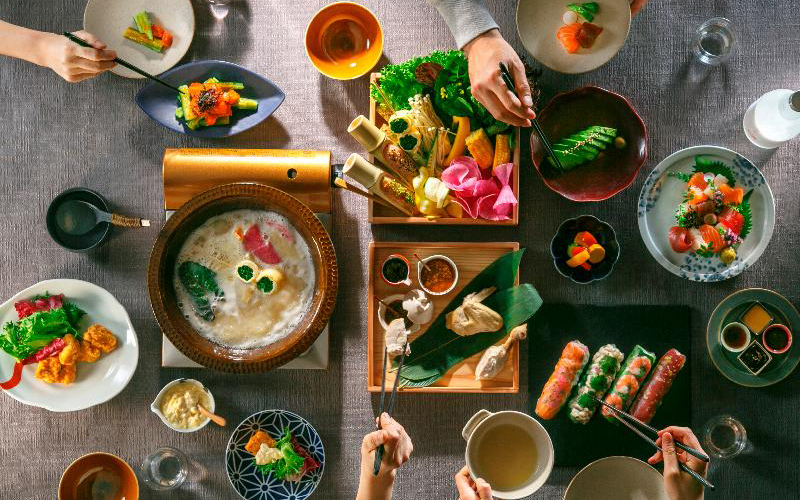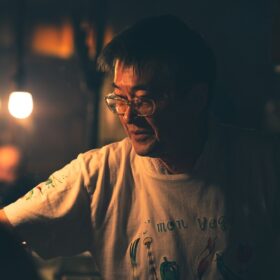Real Japanese cuisine, its characteristics and traditions

The Japanese have a saying: “Food, like a person, cannot appear in society naked”. Perhaps no other cuisine in the world pays as much attention to table setting and serving dishes as the Japanese. Have you ever paid attention to it when dining at restaurants in Japan?
Features of Japanese cuisine
Table setting in Japanese cuisine is striking exactly in the places of traditional recreation, when you come to a certain time and the table is already set. Some incomprehensible clay and metal constructions are standing, and under them is a stack of dry combustibles.
On them are small serving plates for one person, covered with lids. A Japanese woman comes out, lights the fuel under each plate, and the contents begin cooking right in front of you.
In general, they use a lot of different interesting dishes with rice, fish, eggs, pickled daikon. It is a Japanese ritual.
Where you can try Japanese food in Japan
In Japan, you can distinguish three types of catering, where you can try or taste Japanese food. The first is traditional, where the food represents a certain ritual. The second type is a chain of restaurants that are more focused on the process of cooking a variety of Japanese dishes.
As a rule, there is a grill built right in the center of the table for 4 people and a cooker hood. In such establishments, as we have already said in previous articles, it is customary to take off shoes, and the feet are lowered into a special recess under the table, which allows you to rest comfortably.
Japanese waiters bring you different kinds of raw meat, and you cook it yourself right at the table. Often next to these grills there are small stoves with pots in which the greens are already laid. And when asked, all you have to do is drop it into that pan for a few seconds and it’s done.
This way from Japanese cuisine we had a chance to try marbled beef, it turned out very tasty, for some reason it always tastes good when you’re a guest. To be honest, we really liked this scheme of cooking Japanese cuisine, namely marbled beef.
With the portable mini – barbecue, we built something similar at our cottage. Convenient – fried two pieces of meat, ate and then sit, chatting with friends.
The scheme of cooking in Japanese cuisine helps, no need to run, right at your table there is a place to reheat the cooled piece of meat. We say thank you to the Japanese in this regard!
And the third type of Japanese eatery is a quick meal where you can try the rolls. In the center of the room is a serving line with ready-to-eat food. Guests sit around and take whatever plate they want. The main thing is to put the plate on your table so that at the end of the meal the waiters can do a calculation of your order.
There are ten kinds of prices and correspondingly ten plates, very convenient. In such places the shoes are not taken off before entering, as the traffic is high. To the third type of establishments of Japanese cuisine can be attributed many noodle shops where they cook all kinds of noodles with additives.
Products in Japanese cuisine
In Japan you will meet a lot of meat restaurants – grill restaurants, fish restaurants in Japan almost none. Although the Japanese eat a lot of raw fish, it usually goes to make rolls, sashimi.
No matter what restaurant in Japanese cuisine, rice with a variety of additives will please you absolutely everywhere, rice is the main dish of Japanese cuisine. Rice is an integral part of the menu and life of the Japanese.
Miso soup is also found in almost all restaurants in Japan. When it comes to seafood they say that all around Japan have long ago caught everything, so they are imported. But still very fresh and high quality otherwise. About the freshness and quality of Japanese cuisine can be said for sure, the chefs in Japan will never cook from bad products!

Some common foods in Japan include:
- Sushi: a dish made with vinegared rice and various ingredients, such as raw fish, vegetables, and egg.
- Tempura: deep-fried vegetables or seafood coated in a light batter.
- Ramen: a dish of Chinese-style wheat noodles in a meat or fish-based broth, often garnished with sliced pork, dried seaweed, and green onions.
- Udon: thick wheat noodles, often served in a mild, soy-based broth with various toppings such as tempura or thinly sliced beef.
- Okonomiyaki: a savory pancake made with flour, eggs, and shredded cabbage, topped with a variety of ingredients such as seafood, meat, and vegetables.
- Tonkatsu: breaded and deep-fried pork cutlet, usually served with rice, vegetables, and a tonkatsu sauce.
- Shabu-shabu: a hot pot dish in which thin slices of meat and vegetables are cooked in a broth and then dipped in a variety of sauces before being eaten.
Some common ingredients used in Japanese cooking include:
- Rice: a staple grain in Japanese cuisine, often served as a side dish or used to make sushi and other dishes.
- Soy sauce: a fermented sauce made from soybeans, wheat, and salt, used as a condiment and to add flavor to dishes.
- Dashi: a soup stock made from kelp (seaweed) and bonito (tuna) flakes, used as a base for many Japanese dishes.
- Mirin: a sweet rice wine used in cooking to add flavor and shine to dishes.
- Miso: a fermented soybean paste used to make miso soup and as a flavor enhancer in various dishes.
- Sake: a Japanese rice wine, often served as an accompaniment to food or used in cooking.
- Wasabi: a spicy green condiment made from the wasabi plant, often served with sushi and sashimi.
Service in Japanese restaurants and typical features
Service in Japanese restaurants is very fast, you sit down at a table and a waitress comes running to you with a menu. Service in restaurants is very fast and respectful.
The waiter here is called in one word – “Shimisen,” which is Japanese for “Excuse me. As a rule, when you sit on a traditional mat on the floor, you sit low. The waiter comes over and gets down on one knee to write down your order.
The rudeness for Japanese restaurants is nonsense, literally.
Who is the first to be served in restaurants in Japan?
As much as we’ve walked around restaurants in search of new flavors of Japanese cuisine, we’ve noticed one pattern. In the evening, it’s mostly men who sit in restaurants in Japan. During the daytime, there’s almost equal numbers of Japanese of different sexes in mass venues, a large flow of men, women, children with their mothers, and the elderly.
By the way, according to our observations, the Japanese drink a lot and everything in a row: beer, sake or beer with sake. The fact is that the quality of ingredients and products in Japan is very high, so if you drink a lot of sake and beer in the evening, in the morning you can safely run a hundred meters distance, you will not feel unwell.
If you are going to travel in Japan, we definitely recommend you to visit souvenir shopping malls, sightseeing platform in Tokyo, visit the City Hall, but you should definitely finish your trip with a taste of Japanese cuisine in one of the restaurants of the country.
